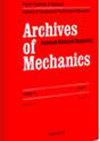超短激光脉冲作用下金属薄膜传热过程的二阶双温度模型
IF 1.2
4区 工程技术
Q3 MATERIALS SCIENCE, CHARACTERIZATION & TESTING
引用次数: 3
摘要
研究了金属薄膜在超短激光脉冲作用下的热过程。所讨论的过程的数学描述是基于四个方程的系统。其中两个方程描述了电子和晶格温度,而第三和第四个方程代表了广义傅里叶定律,它表示电子(晶格)热通量与电子(晶格)温度梯度之间的依赖关系。在广义傅里叶定律中,热通量相对于温度梯度是延迟的,这导致在适当的方程中出现热通量时间导数。根据广义傅里叶定律展开到泰勒级数的阶数,可以得到一阶和二阶模型。与常用的一阶模型不同,本文提出了二阶双温度模型。采用有限差分法的隐式格式求解。并给出了计算实例。结果表明,在低激光强度下,用一阶模型和二阶模型得到的结果非常相似。本文章由计算机程序翻译,如有差异,请以英文原文为准。
Second-order two-temperature model of heat transfer processes in a thin metal film subjected to an ultrashort laser pulse
Thermal processes in domain of thin metal film subjected to an ultrashort laser pulse are considered. A mathematical description of the process discussed is based on the system of four equations. Two of them describe the electrons and lattice temperature, while third and fourth equations represent the generalized Fourier law, it means the dependencies between the electrons (lattice) heat flux and the electrons (lattice) temperature gradient. In the generalized Fourier law the heat fluxes are delayed in relation to the temperature gradients which consequently causes the appearance of heat fluxes time derivatives in the appropriate equations. Depending on the order of the generalized Fourier law expansion into the Taylor series, the first- and the second-order model can be obtained. In contrast to the commonly used first-order model, here the second-order two-temperature model is proposed. The problem is solved using the implicit scheme of the finite difference method. The examples of computations are also presented. It turns out that for the low laser intensities the results obtained using the first- and the second-order models are very similar.
求助全文
通过发布文献求助,成功后即可免费获取论文全文。
去求助
来源期刊

Archives of Mechanics
工程技术-材料科学:表征与测试
CiteScore
1.40
自引率
12.50%
发文量
0
审稿时长
>12 weeks
期刊介绍:
Archives of Mechanics provides a forum for original research on mechanics of solids, fluids and discrete systems, including the development of mathematical methods for solving mechanical problems. The journal encompasses all aspects of the field, with the emphasis placed on:
-mechanics of materials: elasticity, plasticity, time-dependent phenomena, phase transformation, damage, fracture; physical and experimental foundations, micromechanics, thermodynamics, instabilities;
-methods and problems in continuum mechanics: general theory and novel applications, thermomechanics, structural analysis, porous media, contact problems;
-dynamics of material systems;
-fluid flows and interactions with solids.
Papers published in the Archives should contain original contributions dealing with theoretical, experimental, or numerical aspects of mechanical problems listed above.
The journal publishes also current announcements and information about important scientific events of possible interest to its readers, like conferences, congresses, symposia, work-shops, courses, etc.
Occasionally, special issues of the journal may be devoted to publication of all or selected papers presented at international conferences or other scientific meetings. However, all papers intended for such an issue are subjected to the usual reviewing and acceptance procedure.
 求助内容:
求助内容: 应助结果提醒方式:
应助结果提醒方式:


